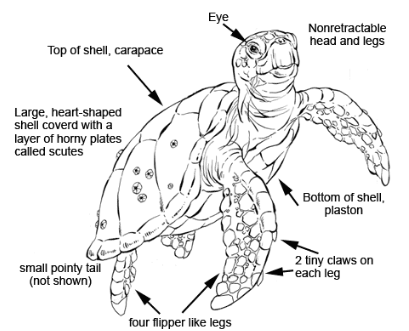Marine Reptiles
Sea turtles, sea snakes, marine iguanas
Characteristics
- Cold Blooded
- Ectothermic
- Body Temperature changes with the environment around them
- Reproduction
- Oviparous
- Lay eggs that hatch after an incubation period
- Incubation: the development of offspring in an egg
Sea Turtles
- Mouth
- Powerful jaws
- No teeth
- Reproduction
- Females breed every 2-4 years
- Lay eggs on land in holes in the sand
- During breeding year, females may lay up to 7 clutches of eggs
- Each clutch has an average of 120 eggs
- Incubation
- Eggs need ~60 days to hatch
- If it’s warmer they will develop more quickly, colder will develop more slowly
- Eggs start out ‘leathery’ but become more brittle before hatchlings escape
- Gender
- Temperature-dependent sex determination
- Gender of hatchling depends on the temperature of the environment egg was in.
- “Pivotal” temperature = 50% male, 50% female
- Higher or lower will produce more males or more females
- Only 7 Species
- Green
- Loggerhead
- Leatherback
- Hawksbill
- Kemp's Ridley
- Olive Ridley
- Flatback
- Species Status
- All species of sea turtles are threatened or endangered
- Endangered means that a species is under direct threat of species survival (extinction is a definite threat)
- Threatened means that the species may become endangered
- Kemp's Ridley Sea Turtle
- Smallest sea turtle
- 3 ft long; 100 lbs
- Most rare sea turtle
- Only known nesting site is in Rancho Nuevo, Mexico
- Site protected by government wildlife agencies
- Green Sea Turtle
- 2 varieties→ Atlantic and pacific
- Only vegetarian sea turtle
- called the green sea turtle because the fat in its body is slightly green as a result of its diet
- Leatherback Sea Turtle
- Largest sea turtle
- 6 ft long; 1000lbs
- Often feed on jellyfish
- Mouth and esophagus are lined with spikes made of cartilage, to prevent prey from escaping
- Threats to Survival
- Statistics
- Each year THOUSANDS of sea turtle hatchlings emerge
- Sadly, only 1 in 1,000 hatchlings survive to adulthood
- Natural threats
- Predators such as racoons, crabs, birds, and cats feed on eggs and hatchlings
- Human-caused threats
- In some cultures, sea turtles are a source of food
- Illegal Sea Turtle Shell Trade
- Bycatch
- Sea turtles are often caught in nets and fishing lines meant to catch other species
- Pollution
- Oil spills
- Debris
- Climate change
- As temperature rises and the polar ice caps melt, sea levels rise
- When sea levels rise that means less beach area for turtles to lay their eggs
- Also, as temperature rises the % of male and female hatchlings being born becomes unbalanced
Sea Snakes
- Statistics
- There are 55 species of sea snakes
- They are ONLY found in the Indian and Pacific Oceans
- Structure
- Long thin body
- Paddle-like tail for propelling through water
- Most species reach 3-4 feet in length as adults
- Reproduction
- Breed at sea
- Unlike sea turtles, most species of sea snakes are ovoviviparous
- Ovoviviparous
- Eggs hatch within body of parent
- Parent gives birth to live young
- Diet
- Sea Snakes are carnivores (eat meat only)
- Diet includes: fish, fish eggs, and eels
- Venom
- BITES from Sea snakes are VENOMOUS
- So venomous, a small drop can be FATAL to humans. (10x stronger than the cobra!)
- Fortunately, they are not known to be aggressive
Marine Reptiles
- Statistics
- ONE species
- Live EXCLUSIVELY on the Galapagos Islands
- Structure
- 2-4 feet in length
- Flattened tail for swimming
- Triangular dorsal spines
- Diet
- Marine Iguanas are herbivores and feed on ALGAE
- Like Polar Bears, marine iguanas do not spend all their time in the water
- They can spend up to an hour underwater
- Sexual dimorphism
- Males and females look different
- Males can be 70% LARGER than females
- Males display BRIGHT COLORS during mating season
- Sneezing
- Often seen with dried salt on body which has been excreted by their nasal glands
